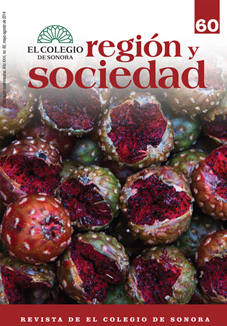 |
 |
 |
 |
 |
 |
 |
 |
 |
 |
 |
 |
Abstract
The North American Free Trade Agreement was implemented in 1994 as a solution to unemployment in rural Mexico. However, the country's rural areas continue to face the same problem today. To determine its impact on employment in Mexico's agricultural sector, the sources of the workforce employment growth from 1994 to 2010 were calculated. Results indicate that the change in production structure was unfavorable to employment in general, although domestic agricultural employment grew by 10 million workdays due to an increase in harvested areas and workforce requirements. In Sinaloa, the change in production structure and increased mechanization negatively affected employment, as opposed to in other states such as Estado de Mexico and Chiapas, where the effect was positive.References
Calva, José Luis. 1992. Probables efectos de un tratado de libre comercio en el campo mexicano. National Association for Chicana and Chicano Studies Annual Conference. http://scholarworks.sjsu.edu/naccs/20_Anniversary/Chicano_Studies/8 (agosto de 2012).
Cámara de Diputados de México. 2002. Asimetrías, productividad y competitividad en el sector agrícola de los países que integran el TLCAN. Servicio de Investigación y Análisis, División de Economía y Comercio. http://biblioteca.diputados.gob.mx/janium/bv/sia/sae/SIA-DEC-45-2003.pdf (julio de 2012).
CESPA. 1984. El empleo de mano obra en las actividades productivas agropecuarias. En El desarrollo agropecuario de México. Pasado y perspectivas, tomo IV. México: CESPA y Secretaría de Agricultura y Recursos Hidráulicos (SARH).
Clavijo, Fernando. 2000. Reformas económicas en México: 1982-1999. México: Comisión Económica para América Latina y el Caribe (CEPAL) y Fondo de Cultura Económica.
CONAPO. 2010. Índices de intensidad migratoria, México-Estados Unidos 2010. http://www.conapo.gob.mx (agosto 2012).
CONEVAL. 2012. Evolución de las dimensiones de la pobreza 19902010. http://www.coneval.gob.mx (agosto de 2012).
De Janvry, Alain y Elisabeth Sadoulet. 1997. El TLC y la agricultura: una evaluación inicial. Investigación Económica LVII (221): 13-60.
FAO. 2012. FAOSTAT, Production. http://faostat3.fao.org (agosto de 2012).
Fujii, Gerardo. 2001. Apertura comercial y empleo agrícola en México, 1993-1998. Momento Económico (115): 45-56.
Hinojosa, Raúl y Sherman Robinson. 1992. Labor Issues in a North American Free Trade Area. Los Ángeles: Robert Lawrence.
INEGI. 2012. Colección de series de cuentas nacionales. http://www.inegi.org.mx/sistemas/bie (junio de 2012).
----------. 2011. Encuesta nacional de ocupación y empleo. http://www.inegi.org.mx (junio de 2012).
----------. 2010. Censo general de población y vivienda 2010. http://www.inegi.org.mx (junio de 2012).
----------. 2005. Conteo de población y vivienda 1995. http://www.inegi.org.mx (junio de 2012).
Matus Gardea, Jaime y Arturo Puente González. 1992. Análisis estatal de los efectos de la política económica y bases de la estrategia para la conversión de la agricultura. México: Centro de Economía del Colegio de Postgraduados y SARH.
Polaski, Sandra. 2003. Jobs, Wages, and Households Income. http://carnegieendowment.org/pdf/files/NAFTA_Report_ChapterOne.pdf (junio de 2013).
Puyana, Alicia y José Romero. 2008. El sector agropecuario y el TLCAN. Efectos económicos y sociales. México: El Colegio de México.
Ruíz, Pablo y Juan Ordaz. 2011. Evolución reciente del empleo y el desempleo en México. Economía UNAM VIII (23): 91-105.
SIAP. 2012. Cierre de la producción agrícola por cultivo 1994 y 2010. http://www.siap.gob.mx (marzo de 2012).
STPS. 1994. Efectos de las reformas económicas y jurídicas sobre el empleo de mano de obra en el sector agropecuario. Subsecretaría B. México, D. F.
Smith, Robert. 2000. Migración, dilemas y perspectivas del sistema migratorio de América del Norte. Comercio Exterior L (4): 289-304.
Williams, Gary. 2004. El Tratado de Libre Comercio de Norteamérica: efectos en la agricultura y en el comercio. Revista Mexicana de Agronegocios VIII (14): 174-196.
Yúnez, Antonio y Fernando Barceinas. 2003. El TLCAN y la agricultura mexicana. Ponencia presentada en el XIX Seminario de Economía Mexicana, México, D. F.
Open access policy
The authors who publish in región y sociedad accept the following conditions:
In accordance with the copyright laws, región y sociedad recognizes and respects the authors’ moral rights, as well as the ownership of property rights, which will be transferred to the journal to disseminate the articles in open access. región y sociedad does not charge the authors for submitting and processing articles for publication.
All the texts published by región y sociedad —with no exception— are distributed under a Creative Commons license 4.0 Attribution – Noncommercial (CC BY-NC 4.0 International), which allows third parties to use the publication as long as they mention the works’ authorship and the first publication in this journal.
The authors can enter into independent and additional contractual agreements for the nonexclusive distribution of the version of the article published in región y sociedad (for instance include it into an institutional repository or publish it in a book) as long as they clearly indicate that the work was published for the first time in región y sociedad.
For all the above, the author(s) must send the Letter of transfer of property rights of the first publication duly filled in and signed by the author(s). This letter can be sent by e-mail as a PDF to: region@colson.edu.mx






